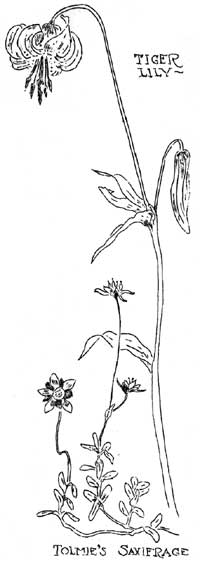
 | ||||||||
| Intro | Author | Volume | Volume/Title | Home | ||||
The height of the flower season is now a thing of the past. Yet, with the arrival of late summer, comes many flowers which vie in beauty with the heathers, the paintbrushes and the Avalanche Lilies which have made this region famous for its abundant and colorful wild flowers. Only occasionally, and then an element of luck enters in, do we find a few blooms of the Avalanche Lily -- though the countless seed pods give evidence of the abundance of this favored flower at the earlier season. Now, perhaps, the most common flower is the Senecio or Ragwort and its tall leafy stems with the numerous bright yellow flowers is a common sight. That it is a member of the Sunflower Family can be easily read in the form of the flower. Thus it owes allegiance to the largest of al plant families. So there are many other of its relatives on our hillsides at the present time--Arnica, Cudweed, Thistle, Erigeron, Pruple Asters, and many others--all of which follow the height of the flower season, preferring the long hours of sunshine and rather dry slopes. 
Growing in the meager soils in the rock slides, or upon the cliffs where a bit of earth has lodged, we find at this time the Harebell or Bluebell swaying gently to and fro in the breeze. So delicate is its fragile beauty that it seems out of place in the harsh, rocky habitat which it prefers. It is without doubt one of the most beautiful flowers on "The Mountain" and once we see it in its native habitat we can readily understand why this flower has been eulogized in song and story. Tolmie's Saxifrage is also very abundant in the barren, rocky soils about timberline. Its small white flowers and bright green leaves form an appreciable contrast to the barren sloped which the hiker traverses at that elevation. Lyall's Lupine is another of these "plant pioneers" which prefer the upper sloped to the meadows below. This dwarfed Lupine has a hairy growth upon its stem and leaves like fur--as if to protect itself from the chill breezes in the exposed situations where it grows. 
Then dropping down again to the subalpine meadows--if we traverse the trails on the warm, dry south and west slopes--we find the regal Tiger Lily growing among the Huckleberry bushes which are already beginning to ripen their fruit. Here, too, we find large beds of the Orange Paintbrush which form, to some extent, and in color from the more common cerise variety which lends its rich color to the moister locations. The False Helebore, crowns its dense cluster of leaves with a tall, open flower arrangement and the entire plant, while not being exactly beautiful, is handsome and very conspicuous because of its large veined and ribbed leaves and characteristic cluster of greenish flowers. This plant and the seed pods of the Western Anemone are the source of more questions than possibly any other for both are very conspicuous, the seed pod of the Anemone being a large shaggy tuft of grey, silky threads--each one of which is attatched to a seed. The Western Anemone is one of our earliest plants in the Hudsonian Zone but beautiful as its flower is, the seed pods form its most interesting feature. In the regions of lower elevation; in the dense forests about the base of "The Mountain" red berries are the principle interest. The Canada Dogwood now lives up to its other common name, Bunchberry, and its clusters of bright red berries form a conspicuous feature along the woodland trails. There is the Red Elderberry also and the prickly Devil's Club is beautified by a dense spike of red berries. While the bright red fruit of the Twisted Stalk makes us appreciate this woodland flower to a greater degree. The fruit of the Wild Lily of the Valley is also distinctive, being small round affairs, greenish in general color but spotted with reddish brown. And everywhere there are cones rapidly approaching maturity. The large cones of the White Pine decorate those trees with their large clusters; Douglas Fir cones are very numerous while the Hemlocks now have at the end of their branchlets their small cones. Thus does Nature leave her impressions of the passing seasons. (C. F. B.) Click to see a copy of the original pages of this article (~116K) | ||||||
| <<< Previous | > Cover < | Next >>> |
http://www.nps.gov/mora/notes/vol8-9-1b.htm
12-Jun-2001